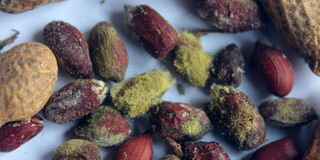Managing aflatoxins in groundnuts

Groundnuts infested with mould causing aflatoxins. To avoid the moulds, farmers are encouraged to practice better post-harvet handling. Photo by Lominda Afedraru.
What you need to know:
- To avoid aflatoxin contamination in groundnuts farmers and processors are urged to follow good practices both at farm management and during post-harvest handling, writes Lominda Afedraru.
Aflatoxins are substances which are not visible and so it is not easy to convince consumers about its existence in food.
Most farmers, traders and consumers in the country are not aware that aflatoxin contaminates food causing health challenges on the consumers.
Contamination can occur in the field, during post-harvest handling drying and storage as well as transportation process, crop husbandry practices and soil factors among others.
There are isolated cases of crops that are vulnerable to aflatoxin which include among others cereal grains such as maize, millet, sorghum and oil seed (groundnuts) including pulses such as beans.
As such scientists breeding groundnuts have realised that aflatoxin is major challenge of the crop and they have come up with guidelines of how farmers can handle the crop especially during post-harvest handling to avoid the challenge.
The head of the groundnut breeding programme at the National Semi Arid Resources Research Institute (NaSARRI) Dr David Kalule Okello interacting with Seeds of Gold about aflatoxin challenge and best practices to curb it had this to discuss as below.
Mycotoxin challenge
Dr Okello explains that there are several species of fungi which affect agricultural grain legumes both in the field and at storage. They include Spergillus, fusarium, penicillum, atltnaria, cladospaium and nigraspora species.
They are associated with cereal grains, nuts and spices. The different species affect the yield of the crop in farmer fields and causing mycotoxins (toxic substances) which is dangerous to human and animal health.
According to Dr Okello, there are more than 200 mycotoxin species which have been reported but those of significance are those that occur naturally in food and feed thereby affecting the safety for human consumption.
Common mycotoxins
These include aflatoxin caused by Aspergillus flavus affecting all cereal grains, legume grains and dried fruits.
Fumonisim caused by fusarium verticillioides and Zearalenome caused by fusarium graminearum common in maize grain.
Ochratoxin caused by aspergillus ochraceous common in coffee and cocoa and patulin caused by penicillium diggitotum affecting apples. Trichothecenes caused by fusarium spp common in wheat, barley, maize and rice.
The most common mycotoxin causing a huge challenge in groundnuts and major cereals consumed in the country is aflatoxin.
Factors
The major factors of contamination in foods and feeds is dependent on biological and environmental forces which lead to formation of mould growth later becoming toxic.
This is culminated by factors such as moisture content in the grain. Once left wet in a storage, may result into mould formation and temperature variation especially during rainy season where drying becomes a problem.
Poor handling and drying practices. Farmers who notoriously dry their groundnuts on bare soil make it prone to mould formation. Others are poor storage conditions and insect infestation
Effects of aflatoxin
Dr Okello notes that aflatoxin infestation in food and feed leads to acute illness and eventual death of humans and animals. The economic effect is acute in that it affects yield and once the product is contaminated, it will be a waste because it no longer has market value.
It is estimated that Africa loses more than $670m annually due to aflatoxin contamination in groundnuts. World over billions of dollars are lost as a result of aflatoxin contamination in foods processed from groundnuts.
In East Africa the standard set for acceptable aflatoxin levels in all foods is 10 as maximum level of tolerance (ppb). In USA it is 20ppb, EU 4ppb and India30ppb.
Post-harvest management
It is important to dry unshelled nuts in thoroughly cured ground or use polythene bags for spreading the pods. Once the pods are dry, shelling, threshing and winnowing must be done carefully to avoid cracked seed were moulding usually takes place.
Farmers are expected to use motorised shellers for those dealing with large volumes of produce. Hand shelling is also recommended where sorting is done on spot.
“In post-harvest storage ensure the seed is completely dry including the storage materials. This will prevent factors such as high humidity and growth of fungi,” says Dr Kalule.
Farmers may decide to store groundnuts with shells or pods in seed form. Dry to the required moisture content, place in packages where there is no humidity, use polybags for storage and put clean kernels into the bag.
Maintain proper storage facilities with aerated ventilators and avoid exposing produce to moisture, control insect pests by observing good storage practices.
It is important to note that groundnut processed for product development is clean and free from moulds. This applies to groundnuts processed into flour and paste. When processing into peanut, it must be well roasted and this is after sorting good seed for roasting.
Processors must avoid processing rejects into flour because already it contains aflatoxin.
Best practices
In order to avoid aflatoxin contamination in groundnuts farmers and processors are urged to follow good practices both at farm management and during post-harvest handling.
At farm management level, farmers are expected to follow right agronomy practices right from observing the right climate condition where planting is done in soils with PH of 5.3 -7.3 with the recommended rainfall density of 300-500mm for medium seeded groundnuts and 1000-1200mm for large seeded varieties.
It is important for farmers to practice crop rotation to avoid pest and disease infestation which may eventually lead to aflatoxin contamination.
Other practices such as seed bed preparation, variety selection, seed dressing and treatment with Rhizobium is important. Observe the right time for planting and good harvest practices.




